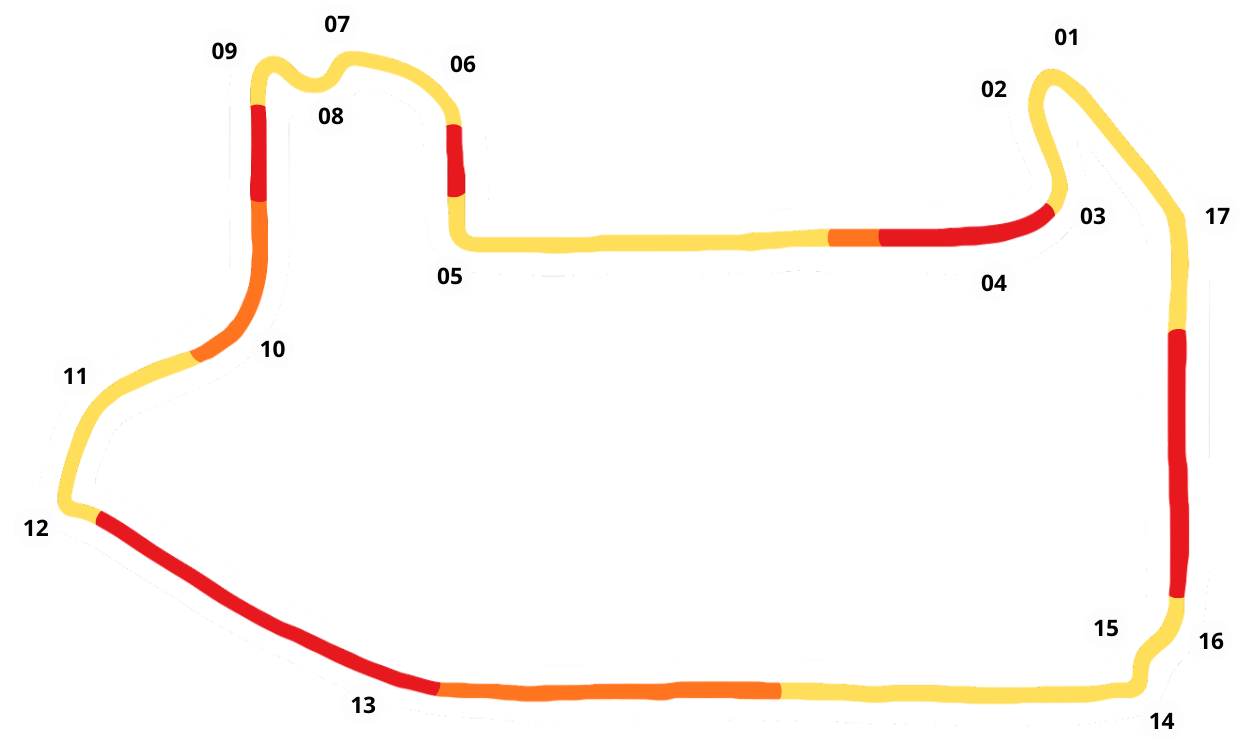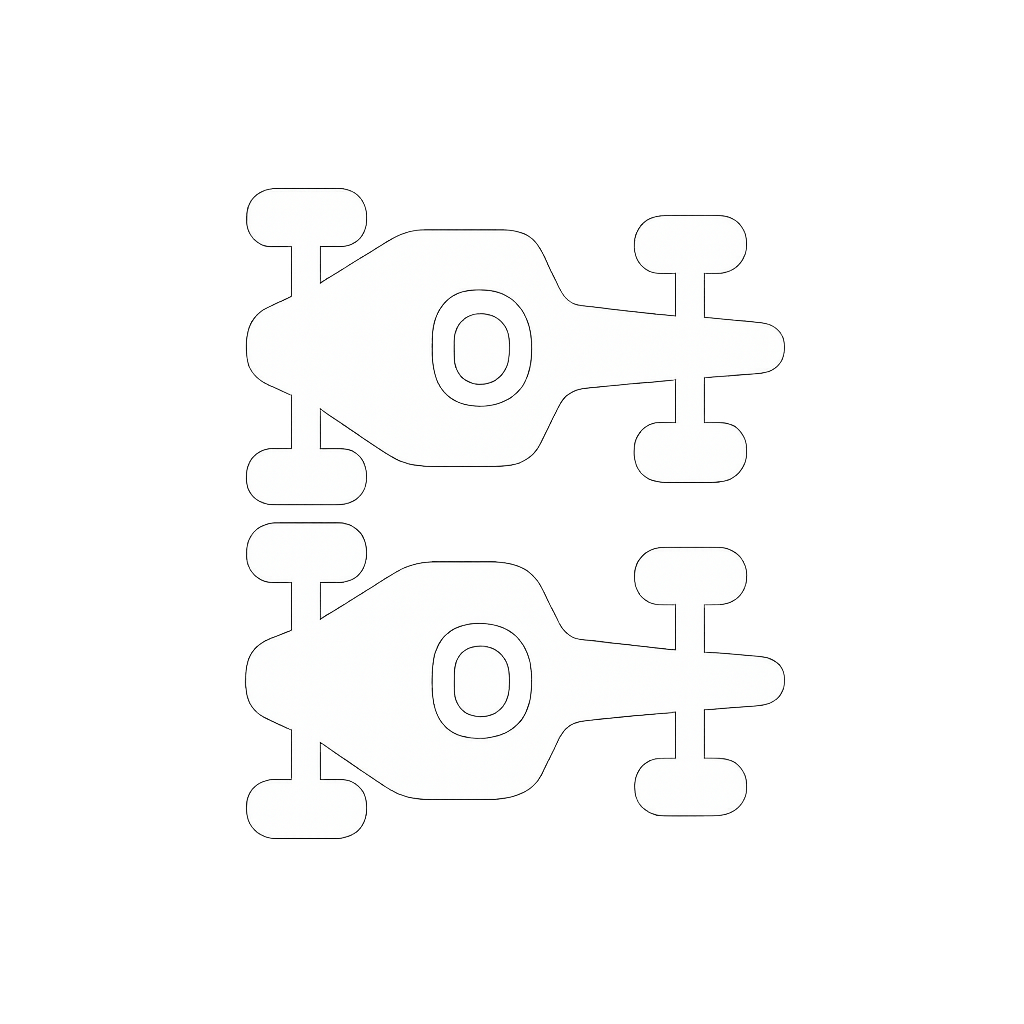
Braking Po!nts
Note: Braking points in this guide are set for HOTLAP only.
In this Corner Guide you’ll find all the key details for every turn on the circuit – from braking points, recommended gears, to curb usage. Each corner is broken down so you know exactly where to brake, which gear to choose, and how to use the entry, inside, and exit curbs to maximize lap time.
Use this guide as your reference to master consistency, improve pace, and get the most out of every lap.
In this Corner Guide you’ll find all the key details for every turn on the circuit – from braking points, recommended gears, to curb usage. Each corner is broken down so you know exactly where to brake, which gear to choose, and how to use the entry, inside, and exit curbs to maximize lap time.
Use this guide as your reference to master consistency, improve pace, and get the most out of every lap.

Corner
Braking point
Gear
Entry curb
Inside curb
Exit curb
01
Start of the curb
X
3
Two on
NO
03
Full throttle
X
5
05
100m board
Drainage cover
3
Two on
07
80m
after Left 100m board
3
attack
08
lift
no braking
3
attack
09
tap the brake
before corner
3
Two on
or NO curb
12
Under the bridge
70m
3
attack
or two on
14
110-120m
Before 100m board
3
NO
15
Little lift
no braking
3
attack
LEGEND:
Curbs:
Attack – Maximum cut to track limits
Two on – Only two tyres on the curb
NO – Do not use the curb
Empty – Curb not present or applies to previous/next corner
Attack – Maximum cut to track limits
Two on – Only two tyres on the curb
NO – Do not use the curb
Empty – Curb not present or applies to previous/next corner
Braking Point
Lift (No Braking)
Full Throttle

Setups
Here you can explore a complete collection of setups designed for every condition on track.Choose between Qualifying setups for maximum one-lap pace, Race setups for consistency and tyre management, or Wet setups to stay competitive in difficult conditions.
BrakePo+nt Setup → balanced downforce, offering a mix of speed and stability.
Safe Setup → highest downforce, best grip in corners, more stable but slower on straights.
Aggressive Setup → lowest downforce, fastest on straights, but harder to handle in corners.
If parc fermé is enabled, just skip qualifying and load the race setup straight away.
Safe Setup → highest downforce, best grip in corners, more stable but slower on straights.
Aggressive Setup → lowest downforce, fastest on straights, but harder to handle in corners.
If parc fermé is enabled, just skip qualifying and load the race setup straight away.
Quali
BrakePo+nt Setup
Aerodynamic
Transmission
Geometry
Suspension
Brakes
Tyres
Transmission
Geometry
Suspension
Brakes
Tyres
00 - 00
000 - 00
0000
0 - 0 - 0 - 0 - 0 - 0
000 - 00
10.0 - 10.0 - 10.0 - 10.0
000 - 00
0000
0 - 0 - 0 - 0 - 0 - 0
000 - 00
10.0 - 10.0 - 10.0 - 10.0
COMING SOON
Quali
Safe Setup
Aerodynamic
Transmission
Geometry
Suspension
Brakes
Tyres
Transmission
Geometry
Suspension
Brakes
Tyres
5 - 0
100 - 30
LLLL
41 - 1 - 3 - 21 - 20 - 43
100 - 54-53
29.5 - 29.5 - 20.5 - 20.5
100 - 30
LLLL
41 - 1 - 3 - 21 - 20 - 43
100 - 54-53
29.5 - 29.5 - 20.5 - 20.5
Updated: 01.09.2025
Quali
Aggressive Setup
Aerodynamic
Transmission
Geometry
Suspension
Brakes
Tyres
Transmission
Geometry
Suspension
Brakes
Tyres
0 - 0
100 - 30
LLLL
41 - 1 - 4 - 21 - 22 - 44
100 - 54-53
29.5 - 29.5 - 20.5 - 20.5
100 - 30
LLLL
41 - 1 - 4 - 21 - 22 - 44
100 - 54-53
29.5 - 29.5 - 20.5 - 20.5
Updated: 01.09.2025
Race
BrakePo+nt Setup
Aerodynamic
Transmission
Geometry
Suspension
Brakes
Tyres
Transmission
Geometry
Suspension
Brakes
Tyres
00 - 00
000 - 00
0000
0 - 0 - 0 - 0 - 0 - 0
000 - 00
10.0 - 10.0 - 10.0 - 10.0
000 - 00
0000
0 - 0 - 0 - 0 - 0 - 0
000 - 00
10.0 - 10.0 - 10.0 - 10.0
COMING SOON
Race
Safe Setup
Aerodynamic
Transmission
Geometry
Suspension
Brakes
Tyres
Transmission
Geometry
Suspension
Brakes
Tyres
2 - 0
100 - 30
LLLL
41 - 1 - 3 - 21 - 20 - 43
100 - 55-53
29.5 - 29.5 - 20.5 - 20.5
100 - 30
LLLL
41 - 1 - 3 - 21 - 20 - 43
100 - 55-53
29.5 - 29.5 - 20.5 - 20.5
Updated: 01.09.2025
Race
Aggressive Setup
Aerodynamic
Transmission
Geometry
Suspension
Brakes
Tyres
Transmission
Geometry
Suspension
Brakes
Tyres
0 - 0
100 - 30
LLLL
41 - 1 - 4 - 21 - 22 - 44
100 - 55-53
29.5 - 29.5 - 20.5 - 20.5
100 - 30
LLLL
41 - 1 - 4 - 21 - 22 - 44
100 - 55-53
29.5 - 29.5 - 20.5 - 20.5
Updated: 01.09.2025
Quali + Race
BrakePo+nt Setup
Aerodynamic
Transmission
Geometry
Suspension
Brakes
Tyres
Transmission
Geometry
Suspension
Brakes
Tyres
00 - 00
000 - 00
0000
0 - 0 - 0 - 0 - 0 - 0
000 - 00
10.0 - 10.0 - 10.0 - 10.0
000 - 00
0000
0 - 0 - 0 - 0 - 0 - 0
000 - 00
10.0 - 10.0 - 10.0 - 10.0
COMING SOON
Quali + Race
Full Wet Setup
Aerodynamic
Transmission
Geometry
Suspension
Brakes
Tyres
Transmission
Geometry
Suspension
Brakes
Tyres
22 - 12
100 - 30
LLLL
41 - 1 - 8 - 21 - 20 - 46
100 - 54-52
29.5 - 29.5 - 20.5 - 20.5
100 - 30
LLLL
41 - 1 - 8 - 21 - 20 - 46
100 - 54-52
29.5 - 29.5 - 20.5 - 20.5
Updated: 01.09.2025
Quali + Race
Wet Setup
Aerodynamic
Transmission
Geometry
Suspension
Brakes
Tyres
Transmission
Geometry
Suspension
Brakes
Tyres
10 - 4
100 - 30
LLLL
41 - 1 - 4 - 21 - 22 - 44
100 - 54-52
29.5 - 29.5 - 20.5 - 20.5
100 - 30
LLLL
41 - 1 - 4 - 21 - 22 - 44
100 - 54-52
29.5 - 29.5 - 20.5 - 20.5
Updated: 01.09.2025

Tyre info
The table shows all key details about tyres during a race.
Each compound includes its wear per lap, expected life span at 50% distance, and the ideal operating window for maximum grip and consistency.
With this information you can adjust your strategy, plan stint lengths, and make the right call on pit stops.
Each compound includes its wear per lap, expected life span at 50% distance, and the ideal operating window for maximum grip and consistency.
With this information you can adjust your strategy, plan stint lengths, and make the right call on pit stops.



Compound
C5
C4
C3
Wear per lap
9.5%
6.4%
5.2%
Life
8 laps
12 laps
15 laps
Ideal window
65 – 85°C
75 – 85°C
75 – 95°C
Tyres

Grand Prix Strategy
The Grand Prix Strategy gives you everything you need to prepare for both qualifying and the race.
You’ll find details like outlap time, fuel load, starting tyre temperatures, and the best point to activate ERS in quali. For the race, you’ll get the expected laps at half distance, recommended fuel amount, pit stop time loss, and pit limiter speed. On the right, the tyre strategy shows the fastest option, an alternative plan, and a possible two-stop strategy – including exact pit windows to help you manage tyres and race pace.
You’ll find details like outlap time, fuel load, starting tyre temperatures, and the best point to activate ERS in quali. For the race, you’ll get the expected laps at half distance, recommended fuel amount, pit stop time loss, and pit limiter speed. On the right, the tyre strategy shows the fastest option, an alternative plan, and a possible two-stop strategy – including exact pit windows to help you manage tyres and race pace.

Qualification
Time for OUTLAP:
2:25
Time for complete a one flying lap.
Quali fuel amount:
5kg
Fuel for complete a one flying lap.
Starting tyre temps:
65°C
Recommended tyre temps for hotlap.
Activate OVERTAKE mode:
Turn 17
Turn ON at this time at the start of lap.

Race
Laps (50% of the race):
25 laps
Number of laps at half of distance.
Race fuel amount:
51.6kg
How much fuel to use at 50% race.
Lost pit stop time:
21 seconds
How muich time you will lost in PITS.
Pit limiter:
80kph/49mph
Speed limiter in the PITS.

Tyre Strategy
Fastest: (One stop)


Pit Window:
Lap 9 - 10
Lap 9 - 10
Alternative: (One stop)


Pit Window:
Lap 15 - 16
Lap 15 - 16
Alternative+: (Two stop)



6
16
16

ERS Management

OVERTAKE

HOTLAP

MEDIUM
Quali Usage:
For the fastest qualifying laps, it’s important to adapt your ERS mode to each section of the track. Smart energy management ensures you extract maximum performance across a single lap. Never use HOTLAP — only on long straights after pressing OVERTAKE, but it’s usually better to just stay on OVERTAKE longer.
Race Usage:
During the race, use OVERTAKE only in short bursts on the straights, keep MEDIUM active for most of the lap, and switch to NONE through corners to recover energy efficiently.
For the fastest qualifying laps, it’s important to adapt your ERS mode to each section of the track. Smart energy management ensures you extract maximum performance across a single lap. Never use HOTLAP — only on long straights after pressing OVERTAKE, but it’s usually better to just stay on OVERTAKE longer.
Race Usage:
During the race, use OVERTAKE only in short bursts on the straights, keep MEDIUM active for most of the lap, and switch to NONE through corners to recover energy efficiently.


Circuit info
The Circuit Info section provides a quick overview of the track.
It includes the lap counts for race and sprint, total circuit length, number of DRS zones, and possible overtaking spots. You’ll also find the pole position side, reference AI lap time at 110%, and key ratings such as track grip, tyre wear, downforce level, and average speed.
Use this information to understand the character of the circuit and prepare your setups and strategy accordingly.
It includes the lap counts for race and sprint, total circuit length, number of DRS zones, and possible overtaking spots. You’ll also find the pole position side, reference AI lap time at 110%, and key ratings such as track grip, tyre wear, downforce level, and average speed.
Use this information to understand the character of the circuit and prepare your setups and strategy accordingly.

50% race lap count
25 laps

Sprint lap count
N/A

Race lap count
50 laps

Circuit lenght
6.201 km

DRS zones
2

Overtaking zones
Turn 1, 5, 12, 14

Pole Position
Right Side

AI 110% difficulty time
1:32.483

Track grip

Tyre wear

Downforce

Average speed

Tips and tricks
Setup tips:
Aerodynamics:
Low–medium downforce is best – straight-line speed is important, but keep enough stability so the car remains manageable in slow corners.
Transmission:
A more open on-throttle diff helps maintain traction out of the hairpins.
Suspension:
Softer suspension is useful on a street circuit to handle bumps and kerbs effectively.
Brakes:
Medium–high pressure with a rearward bias helps avoid front lockups in heavy braking zones.
Tyres:
Rear tyres can overheat easily in the stop–start sections – manage wheelspin carefully to protect them.
Race tips:
Braking precision is crucial – the track starts and ends with heavy braking zones where small mistakes can cost a lot of time.
Focus on clean exits from slow corners, as they lead onto long straights where top speed and DRS matter most.
The long straights are overtaking hotspots – maximise slipstream and ERS usage to gain positions.
Be careful through the fast kinks and direction changes – walls are close, and even a small error can ruin the lap.
Patience on throttle is key in the final sector – rushing inputs leads to understeer or wheelspin.
A strong exit onto the pit straight is essential to finish the lap and create overtaking opportunities.

